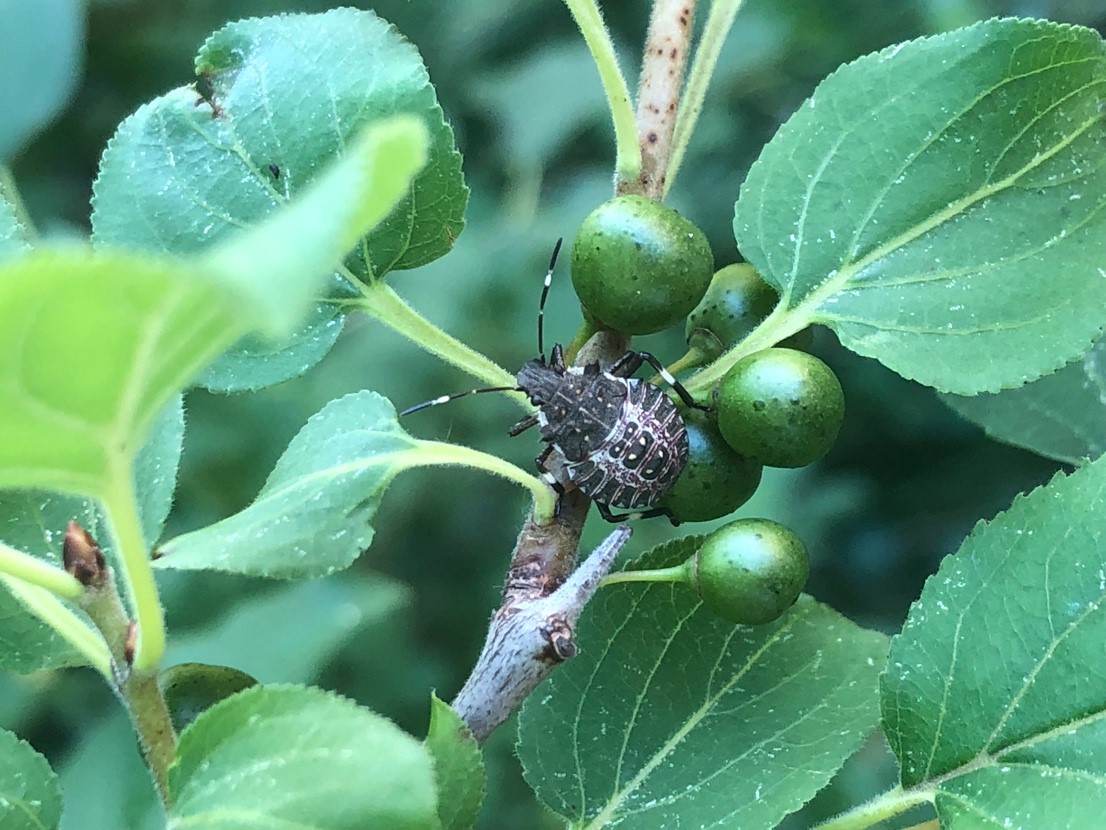Michigan brown marmorated stink bug update – July 10, 2018
Watch out for early feeding damage by brown marmorated stink bugs in developing Gala, Honeycrisp and Golden Delicious apples. Nymphs can be found in abundance on non-crop hosts in some areas.

We continue to catch brown marmorated stink bugs in monitoring traps in commercial vineyards and in apple and peach orchards, mainly in the southern part of Michigan. We are also starting to see damage in developing apples, particularly on young trees that have been interplanted to fill in gaps in older orchards (Photo 1).
This time of year, based on growing degree-days used in a model to predict brown marmorated stink bug activity, adults continue to lay eggs and a variety of different nymph stages can be found on non-crop hosts, such as buckthorn (Photo 2). As nymphs continue to move around in the landscape, crops near favored hosts are expected to be at higher risk of feeding injury.
In peaches, fresh evidence of damage will look like little beads of sugar water on the exterior of the fruit. In apples, damage may occur in a line around the fruit and when you cut into the damaged areas, a distinct browning line may be seen where the insect’s mouthparts were inserted for feeding.

Photo 2. Brown marmorated stink bug nymph on buckthorn. Photo by Amy Irish-Brown, MSU Extension.
In addition to the other materials listed as effective against brown marmorated stink bugs in tree fruit (see Michigan State University Extension’s “2018 Michigan Fruit Management Guide,” E154) for the 2018 growing season, Michigan pome and stone fruit growers also have a special use label (Section 18) for dinotefuron (sold as Venom or Scorpion) available to them. Contact your local MSU Extension educator to obtain a copy of the label if you would like to use one or the other of these products as it is not yet posted to the Michigan Department of Agriculture and Rural Development website.
To know whether this pest is active in your orchard, use limb-jarring over a white sheet or tray and stink bugs will drop out of the tree onto the tray. Do this in trees at the edges of orchards next to woodlots and at the margins of orchards that had evidence of feeding damage last year. There is no threshold for triggering management using the limb-jarring method, but if you are finding nymphs or adults in orchard edges it would be a good idea for your next cover spray to use a material that is also effective against brown marmorated stink bugs.
A threshold has been developed for brown marmorated stink bugs using traps baited with the Trece dual lure. The recommendation is to count the number of nymphs and adults that accumulate in perimeter traps around a 10-acre or less orchard block, and when 10 brown marmorated stink bugs (nymphs or adults) have been captured, that triggers a spray. Start the accumulation count over once a spray has been applied.
For more information about how to manage this pest in orchards, download the free "Managing Brown Marmorated Stink Bug in Michigan Orchards" from MSU, updated July 2018. You can also visit the MSU Brown Marmorated Stink Bug webpage or StopBMSB.



 Print
Print Email
Email




